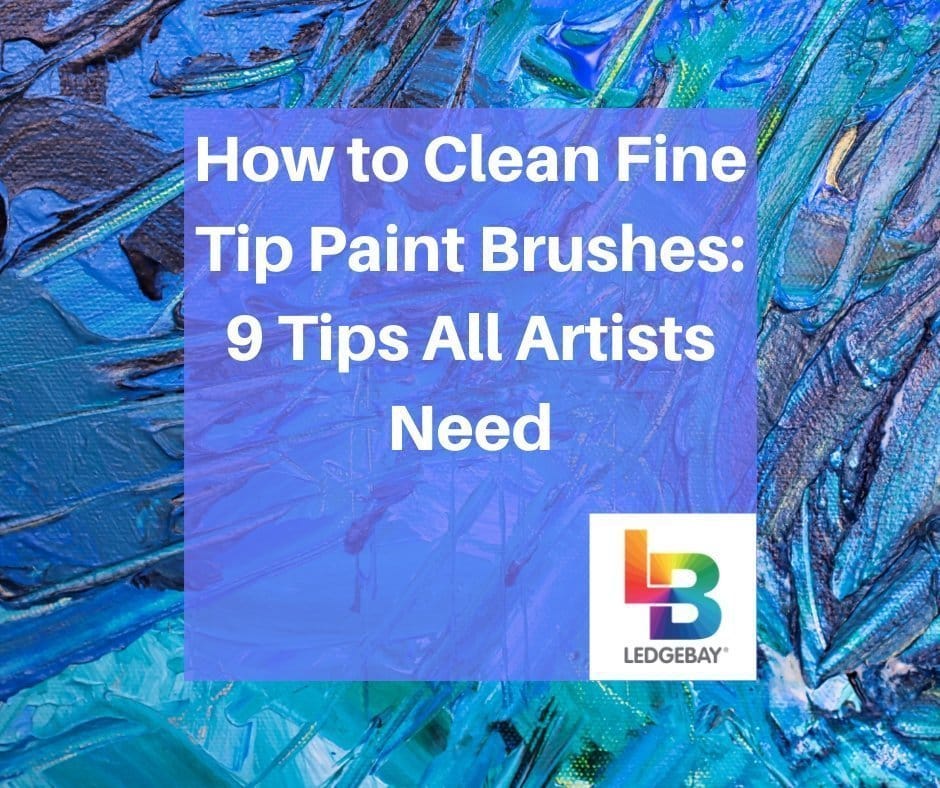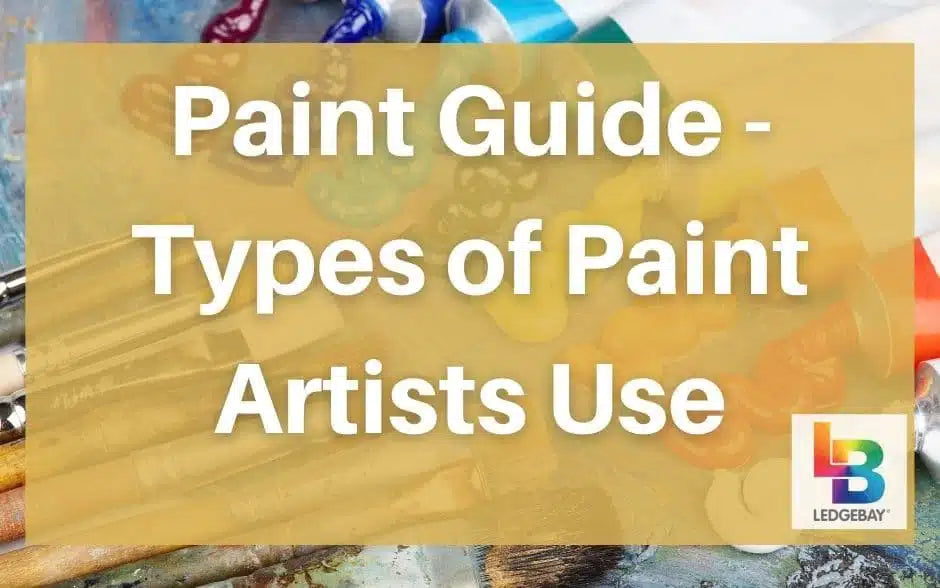Every year, tons of people addpainting or creating to their list of resolutions, and for good reason!
Studies have found thatpainting can help to relieve mental and emotional distress while increasing cognitive skills such as memory. Plus, there's no better feeling than looking at a work of art and knowing that you are responsible for its existence.
The only thing holding some budding artists back is the cost of supplies, especially when they find themselves replacing supplies constantly.
A good set ofpaint brushes is an artist's best friend. Read on to find out how to take care of your finetip paint brushes so that they last for the entire year!
First, let's get to know yourpaint brushes ! While the materials and sizes may differ, the anatomy of a detailpaint brush is fairly consistent.
The tip refers, of course, to the end of your paint brush's bristles. While some detailpaint brushes have more of a flattened edge, finetip paint brushes tend to have a pointed tip.
The middle part of your bristles is called the belly because this is where the bristles swell. Finetip paint brushes have a small belly and are less likely to absorb extra paint.
The ferrule is the metal piece that provides structural support for the bristles and attaches them to the handle. You'll notice a pinch-point at the edge of the ferrule closest to the handle. This is referred to as the crimp.
The handle is the longest part of apaint brush and is often made of wood . You want to find a brush that has a thicker grip between the middle of the handle and the crimp. This is where you'll hold your brush most often and this widened grip creates an ergonomic shape.
You'll notice that paint brush sets tend to go for anywhere from $5 to hundreds of dollars. Why? The finest quality bristle materials come at an extremely high price.
Kolinsky sable-hair brushes are highly coveted by artists and have been for well over a hundred years. They were first made in 1866 at the behest of Queen Elizabeth, who was in search of theperfect brush for painting with watercolors. Kolinsky sable hair comes from a rare Siberian weasel whose hair is rumored to be worth three times its weight in gold.
As you can imagine, these extra fine detailpaint brushes are incredibly expensive ! Fortunately, you don't have to spend that much money to get a high-quality brush. Look for paint brushes with high-quality nylon bristles that compare to sable in feel and durability.
Oncepaint dries on the bristles of a brush, it is much harder to clean. This will cause the bristles to stiffen and spread, creating uneven brush strokes in the future. Keep your fine detail paint brushes wet when they're in use and clean them as soon as you're done using them.
When working withacrylic paint , keeping a brush wet can become complicated. Acrylic paint usesa plastic polymer as a binder, which becomes chemically altered by water. While you may not notice any negative effects in the short run, watered-downacrylic paint will start to flake off of the canvas in the years to come.
In other words, you don't want thepaint to dry on your brushes but you also don't want to water down your acrylic paint. The solution? Wash each brush before setting it down for more than ten minutes at a time!
(If you don't have enough time for this, keep a cup of clean water and a rag orpaper towel at your painting station. When you know you need to put a brush down for a while, swish it in yourwater and then squeeze out the water and excess paint with the rag or paper towel. Make sure you're squeezing and not pulling, or you may pull some of the bristles out.)
While it seems intuitive to use scalding hot water to clean just about anything, you're going to want to stay in more of a lukewarm zone with your brushes. Some websites may suggest soaking your hard-to-wash brushes in boiling water, but this is not your best plan of action.
Hot water causes both acrylic andoil paints to clot. That means that rather than washing away excess paint, you'll end up withthick pieces of stuck-on dried paint that alter the shape of the bristles.
You can purchase pointpaint brush cleaning detergent or you can head over to your sink and grab what's already there!
Run lukewarm water and pump a dime-sized drop of dish soap onto your fingers. Wet the bristles and give them a good shampoo of dish soap. Continue doing this until thepaint residue is gone and the water running through the bristles is clear.
Sometimes a regular washing with dish soap just won't cut it, especially if you'retrying to revive neglected paint brushes.
If you've been working withoil paint , soak your bristles in olive oil for 20 to 25 minutes. Whilewater separates from oil and may not soak into the oil paint properly, olive oil should do the trick.
If you've been working withacrylic paint , pour white vinegar into a microwave-safe cup or bowl and heat it for about 45 seconds or until warm. Let your brushes soak in the warm vinegar for 10 to 15 minutes.
You can also use nail polish remover instead of olive oil or vinegar. However, some people find the smell of nail polish remover to be intolerable! (Vinegar, too, has a strong smell, but it dissipates more quickly.)
After soaking yourpaint brushes in either olive oil or vinegar, rinse them thoroughly with lukewarm water. Olive oil-soaked brushes will take longer to clean but a little help from your dish soap will do the trick.
[amazon box="B08KT72CRR"]
Even the cleanest of paint brushes may harden over time. However, all hope is not lost!
Grab some chemical-free baby oil, preferably with a base of mineral oil and aloe extract, and let yourpaint brushes soak for 10 to 15 minutes. Once this is complete, clean them with lukewarm water and dish soap, as per usual.
Stiff brushes tend to have paint residue on them, even if they look clean. The baby oil will help to loosen that residue while also conditioning the bristles so that they're soft and pliable like they were when you purchased them!
However, this area is what gives the tip its shape. If you let old paint build up around the ferrule, individual bristles may lose their length or bend at odd angles, resulting in a thin or uneven brush stroke.
The best way to protect your ferrule is to avoid drenching it in paint in the first place. That means that you don't want to submerge your brush past the belly of the bristles when dipping it into your paint.
If your ferrule does get gunked up withacrylic paint over time, grab a sewing needle, some rubbing alcohol, and a few paper towels.
Soak the bristles in rubbing alcohol and then squeeze as much of the excess paint out of it with the paper towel as you can. Then, take your sewing needle and very gently push it between the bristles near the ferrule. Move it from the base towards the tip of the brush, coaxing any paint away from the ferrule.
Repeat these steps a few times until the base of the bristles look cleaner and feel more pliable.
Finally, never store your brushes with the bristles touching a hard surface. In other words, do not store them bristle-side down. Not only will this create an oddly-shaped tip but the pressure on the bristles will cause fraying or breaking.
Instead, you can store them horizontally or with the bristles facing up. Make sure that the bristles of one paint brush are not touching or leaning on the bristles of another.
If you have questions about our products or about the world ofpainting , contact us at support@ledgebay.com or fill out our customer contact sheet at the bottom of the page!
Studies have found thatpainting can help to relieve mental and emotional distress while increasing cognitive skills such as memory. Plus, there's no better feeling than looking at a work of art and knowing that you are responsible for its existence.
The only thing holding some budding artists back is the cost of supplies, especially when they find themselves replacing supplies constantly.
A good set ofpaint brushes is an artist's best friend. Read on to find out how to take care of your finetip paint brushes so that they last for the entire year!
1. Know the Anatomy of a Paintbrush
[amazon box="B07RFHG7D1"]First, let's get to know yourpaint brushes ! While the materials and sizes may differ, the anatomy of a detailpaint brush is fairly consistent.
The tip refers, of course, to the end of your paint brush's bristles. While some detailpaint brushes have more of a flattened edge, finetip paint brushes tend to have a pointed tip.
The middle part of your bristles is called the belly because this is where the bristles swell. Finetip paint brushes have a small belly and are less likely to absorb extra paint.
The ferrule is the metal piece that provides structural support for the bristles and attaches them to the handle. You'll notice a pinch-point at the edge of the ferrule closest to the handle. This is referred to as the crimp.
The handle is the longest part of apaint brush and is often made of wood . You want to find a brush that has a thicker grip between the middle of the handle and the crimp. This is where you'll hold your brush most often and this widened grip creates an ergonomic shape.
2. Choose the Right Bristle Material
[amazon box="B000YQG9ZK"]You'll notice that paint brush sets tend to go for anywhere from $5 to hundreds of dollars. Why? The finest quality bristle materials come at an extremely high price.
Kolinsky sable-hair brushes are highly coveted by artists and have been for well over a hundred years. They were first made in 1866 at the behest of Queen Elizabeth, who was in search of theperfect brush for painting with watercolors. Kolinsky sable hair comes from a rare Siberian weasel whose hair is rumored to be worth three times its weight in gold.
As you can imagine, these extra fine detailpaint brushes are incredibly expensive ! Fortunately, you don't have to spend that much money to get a high-quality brush. Look for paint brushes with high-quality nylon bristles that compare to sable in feel and durability.
3. Don't Let Paint Dry on Your Paint Brushes
[amazon box="B09NRJMCH2"]Oncepaint dries on the bristles of a brush, it is much harder to clean. This will cause the bristles to stiffen and spread, creating uneven brush strokes in the future. Keep your fine detail paint brushes wet when they're in use and clean them as soon as you're done using them.
When working withacrylic paint , keeping a brush wet can become complicated. Acrylic paint usesa plastic polymer as a binder, which becomes chemically altered by water. While you may not notice any negative effects in the short run, watered-downacrylic paint will start to flake off of the canvas in the years to come.
In other words, you don't want thepaint to dry on your brushes but you also don't want to water down your acrylic paint. The solution? Wash each brush before setting it down for more than ten minutes at a time!
(If you don't have enough time for this, keep a cup of clean water and a rag orpaper towel at your painting station. When you know you need to put a brush down for a while, swish it in yourwater and then squeeze out the water and excess paint with the rag or paper towel. Make sure you're squeezing and not pulling, or you may pull some of the bristles out.)
4. Don't Use Hot Water on Your Paint Brushes
[amazon box="B08BNJJDBX"]While it seems intuitive to use scalding hot water to clean just about anything, you're going to want to stay in more of a lukewarm zone with your brushes. Some websites may suggest soaking your hard-to-wash brushes in boiling water, but this is not your best plan of action.
Hot water causes both acrylic andoil paints to clot. That means that rather than washing away excess paint, you'll end up withthick pieces of stuck-on dried paint that alter the shape of the bristles.
5. Lather Up with Dish Soap
[amazon box="B01M6779ER"]You can purchase pointpaint brush cleaning detergent or you can head over to your sink and grab what's already there!
Run lukewarm water and pump a dime-sized drop of dish soap onto your fingers. Wet the bristles and give them a good shampoo of dish soap. Continue doing this until thepaint residue is gone and the water running through the bristles is clear.
6. Use Olive Oil or Vinegar for Hard-to-Wash Paints
[amazon box="B017ALC6GW"]Sometimes a regular washing with dish soap just won't cut it, especially if you'retrying to revive neglected paint brushes.
If you've been working withoil paint , soak your bristles in olive oil for 20 to 25 minutes. Whilewater separates from oil and may not soak into the oil paint properly, olive oil should do the trick.
If you've been working withacrylic paint , pour white vinegar into a microwave-safe cup or bowl and heat it for about 45 seconds or until warm. Let your brushes soak in the warm vinegar for 10 to 15 minutes.
You can also use nail polish remover instead of olive oil or vinegar. However, some people find the smell of nail polish remover to be intolerable! (Vinegar, too, has a strong smell, but it dissipates more quickly.)
After soaking yourpaint brushes in either olive oil or vinegar, rinse them thoroughly with lukewarm water. Olive oil-soaked brushes will take longer to clean but a little help from your dish soap will do the trick.
[amazon box="B08KT72CRR"]
7. Soak Hardened Brushes in Baby Oil
[amazon box="B00WEBVM5U"]Even the cleanest of paint brushes may harden over time. However, all hope is not lost!
Grab some chemical-free baby oil, preferably with a base of mineral oil and aloe extract, and let yourpaint brushes soak for 10 to 15 minutes. Once this is complete, clean them with lukewarm water and dish soap, as per usual.
Stiff brushes tend to have paint residue on them, even if they look clean. The baby oil will help to loosen that residue while also conditioning the bristles so that they're soft and pliable like they were when you purchased them!
8. Don't Neglect the Base of Your Paint Brushes
It can bedifficult to get to the paint stuck between the ferrule and the base of the bristles. Many artists neglect this area because it can be tedious and it may not appear to affect the tip of the brush.However, this area is what gives the tip its shape. If you let old paint build up around the ferrule, individual bristles may lose their length or bend at odd angles, resulting in a thin or uneven brush stroke.
The best way to protect your ferrule is to avoid drenching it in paint in the first place. That means that you don't want to submerge your brush past the belly of the bristles when dipping it into your paint.
If your ferrule does get gunked up withacrylic paint over time, grab a sewing needle, some rubbing alcohol, and a few paper towels.
Soak the bristles in rubbing alcohol and then squeeze as much of the excess paint out of it with the paper towel as you can. Then, take your sewing needle and very gently push it between the bristles near the ferrule. Move it from the base towards the tip of the brush, coaxing any paint away from the ferrule.
Repeat these steps a few times until the base of the bristles look cleaner and feel more pliable.
9. Reshape Your Brushes and Store Them Properly
After cleaning your paint brushes, you will need to reshape the tip before they dry. Use your fingers to do this because a paper towel or rag may create friction and pull some of the bristles out.Finally, never store your brushes with the bristles touching a hard surface. In other words, do not store them bristle-side down. Not only will this create an oddly-shaped tip but the pressure on the bristles will cause fraying or breaking.
Instead, you can store them horizontally or with the bristles facing up. Make sure that the bristles of one paint brush are not touching or leaning on the bristles of another.
Get Painting!
Now that you know a thing or two (or nine) about keeping your paint brushes clean, it's time to start painting! Not sure where to start? Check out our most popularpaint by number kits !If you have questions about our products or about the world ofpainting , contact us at support@ledgebay.com or fill out our customer contact sheet at the bottom of the page!











